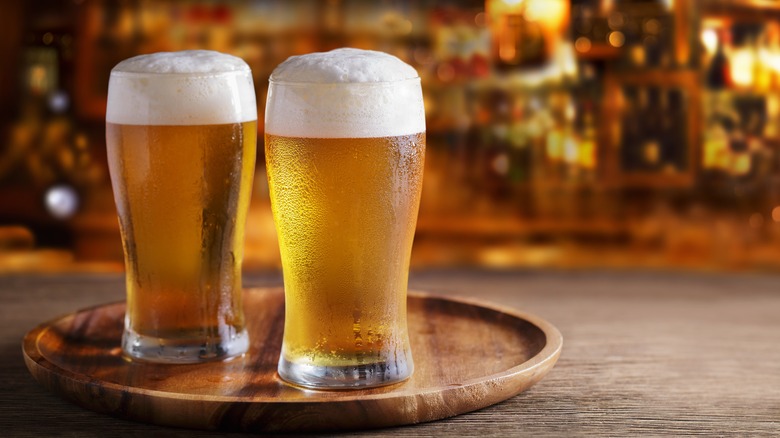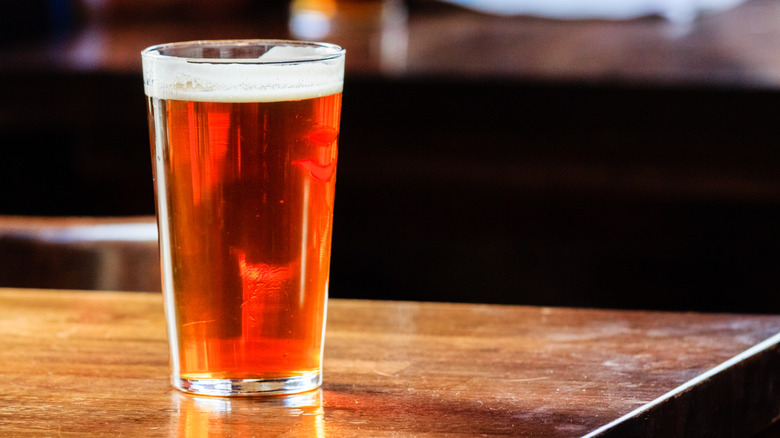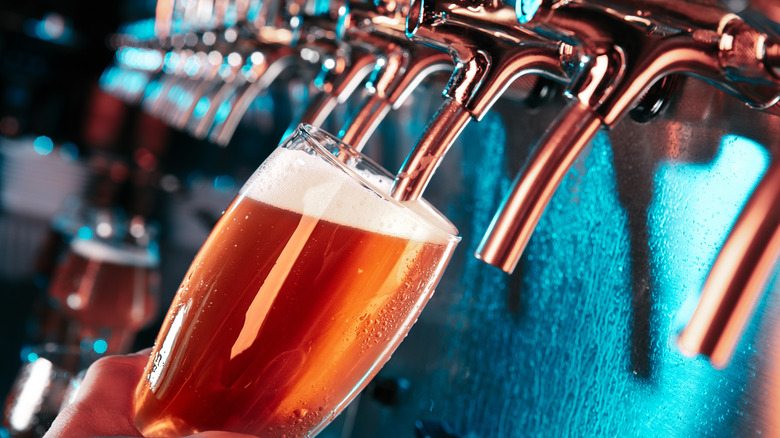New York City Doesn't Quite Know What The Size Of A Pint Is
In the food world, certain terms might not be used in their true meaning. When a friend says "Let's grab a beer," it might not be a lager in that glass; but the sentiment behind the statement is understood. When it comes to measurements, though, words should matter. As any baker appreciates, there is a big difference between a teaspoon and a tablespoon.
However, when a New York City bar refers to a pint, it might not be the measurement that many people assume. Although guests might say "Give me a pint," that phraseology may not equate to a specific measured pour in the glass. While some people drink beer from a bottle or a can, a draft beer might come in differently shaped glasses, depending on the bar, brewery, or even restaurant. And — unlike the rules in math class — a pint of beer in a bar can be different, depending on where it is served.
Putting aside a too-frothy head from an inexperienced bartender, a pint in New York City is different than the same beer served in Canada or the U.K. According to The Beer Connoisseur, beers are generally served in 4-ounce, 8-ounce, and 16-ounce options in the U.S. In comparison, an imperial pint, which is the standard in Canada and the U.K., is 20 ounces. While it is not a metric-versus-customary system debate, the reality is, for the beer drinker who enjoys a great English ale, it might feel that some bars are short pouring their beer.
Should beer pint sizes be a standard pour measure?
Within the bar world, local regulations at the city and state levels can govern many aspects of how, where, and when alcohol is consumed. When it comes to the glassware the establishment uses, the amount poured into the glass can vary. Even though people might request a pint, it might be more about the style of glass than the number of ounces. According to Smithsonian Magazine, the U.S. does not legislate pint size. Although 16 ounces is considered a standard pour, bars do not have to conform to that custom. In comparison, the U.K. has a very specific standard for its pint measurement. The imperial pint is about 586 milliliters, or some refer to the amount as 20 ounces.
Recently, Grub Street published one beer writer's lament over the lack of true imperial pint pours in New York City. While the various English bars had their excuses for the less-than-full draft, the ambiance of the Union Jack on the wall or even Premiere League on television might be the only reference to an authentic pub experience. Although the ounces in the glass matter, it may be the style and consumption of the beer that impacts the overall experience.
More importantly, the beer drinker should be aware of the amount being drunk. Four ounces might not seem like a lot, but it does make a difference with alcohol. Although no one needs to bring a measuring cup to the bar, a little knowledge can be helpful. After all, drinking two 20-ounce beers versus two 16-ounce beers can make a big difference by the end of the night.
How much beer should drinkers expect in that pint glass?
As beer drinkers discover the difference between an imperial pint and other pints, there is another layer of knowledge that might have some people wondering if the glass is truly full. In a frothy discussion by IndianaOnTap.com, the author reveals that drinkers might not be consuming a full 16 ounces of that IPA, lager, or stout. Given that the glass holds a total of 16 ounces, the person pouring the draft beer would have to fill the liquid to the lip, with no head. Since many beers leave room at the top or have an inch of head, the actual beer consumed might be more like 14-15 ounces of beer.
Before some drinkers complain about "shrinkflation" or getting cheated by the bartender, this situation is not necessarily a new phenomenon. Pulling the perfect draft beer is an art and not an exact science. For beer drinkers who always want to know the precise number of ounces consumed, they may prefer to enjoy their libation from a can or a bottle, which clearly denotes the ounces inside the container. And, if they prefer to drink from a cold glass, they can pour that carefully measured hoppy beverage into another vessel.


